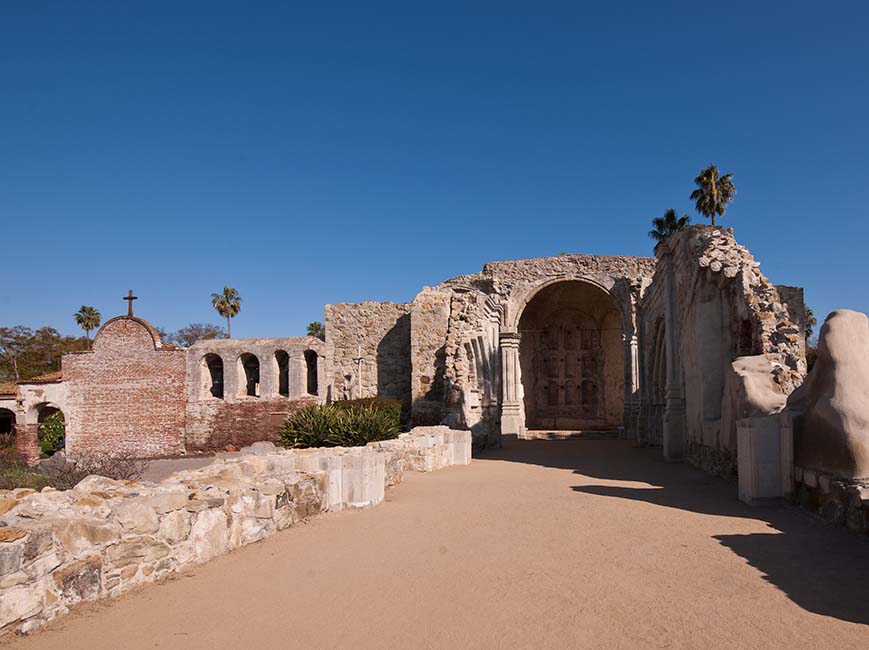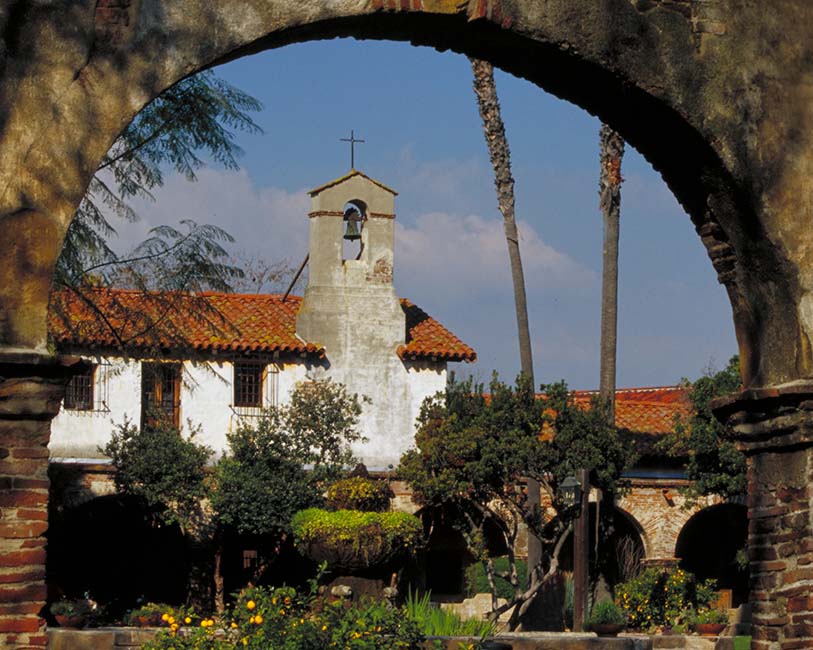Address
26801 Ortega Highway
San Juan Capistrano, CA 92675
United States

Founded:
November 1, 1776 - The 7th California Mission
Also Called:
The Jewel of the Missions
Current Status:
The Mission San Juan Capistrano Basilica (a large modern church) and the Serra Chapel are part of the Catholic Parish of San Juan Capistrano.
Summary:
San Juan Capistrano was founded on November 1, 1776. This mission, designated the “Jewel of the Missions,” contains picturesque ruins, a distinctive bell wall, and beautifully landscaped grounds. Mission San Juan Capistrano is a popular destination known for its many special events, particularly “The Return of the Swallows.”
26801 Ortega Highway
San Juan Capistrano, CA 92675
United States
Easily reached from US-5. Take the Ortega Highway / CA-74 Exit East. The mission is less than one-half mile, on the right.
https://missionsjc.com - Mission
https://missionparish.org - Parish
949-234-1300 - Mission
949-234-1360 - Basilica of San Juan Capistrano Parish Office
Please contact the mission directly by telephone or by visiting the mission website for the most current information.
Due to Covid-19 restrictions, it is best to check for current information.
Weddings are held in the Basilica on Fridays and Saturdays. All religious services are managed directly by the Parish. Contact the Parish Office at 949-234-1360 for specific details.
Mission San Juan Capistrano is a unique destination that contains many historic structures, some special displays, picturesque gardens, and fountains in the front and back quadrangle, and is known for the number and quality of the special and recurring events it offers.
We recommend that visitors decide whether they will visit the mission when there is a special event (there are over twenty), decide whether they wish to participate in a recurring event, and make sure they allow enough time to see and appreciate all of the historic structures.
The mission website calendar contains a comprehensive list of special and recurring events. Check this out prior to arranging your visit to take advantage of some of these exciting events.







1833
1865 in a Decree signed by President Abraham Lincoln
St. John of Capistrano, a 14th century Theologian

The Takic speaking people of the Acjachemen villages. Neophytes associated with San Juan Capistrano have been called Juaneño since the Spanish occupation.
Located within sight of the ocean in the town of San Juan Capistrano, which developed around the mission.
Traditional quadrangle
Three streams - the Trabuco, Horno, and San Juan - converged at the mission.
This mission grew steadily, exceeding 1,000 neophytes by 1797. The highest recorded population was 1,361 in 1812. Even in 1833 when the mission was secularized, 861 neophytes were still living at San Juan Capistrano.
In 1783 (the first year for which we have detailed records), the mission had 430 cattle, 305 sheep, 830 goats, 40 pigs, 32 horses, and 1 mule for a total of 1,638 animals. In 1819 (the peak year), the mission had over 31,000 animals, including 14,000 cattle and 16,000 sheep.

Agricultural production was significant. Over the years 1783-1831, San Juan Capistrano harvested 234,879 bushels of wheat, barley, corn, beans, peas, lentils, garbanzos (chickpeas), and habas (broad beans).
In 1778, two years after the mission was moved to the present site a small adobe chapel was built, but was soon replaced by the Serra Chapel in 1782. This is the only remaining church in which Fr. Serra held mass.
In order to accommodate the mission's growing population, the Great Stone Church was constructed between 1797-1806. This cathedral-like building was 180 feet long by 40 feet wide, and had a high-vaulted ceiling surmounted by seven domes fronted by a 120-foot tall bell tower. In December 1812, a massive earthquake destroyed the Great Stone Church, killing 40 neophytes.


The four bells that hung in the Great Stone Church survived the earthquake, and were hung in a bell wall, one of the mission's most picturesque features.
The two largest bells were cast in 1796, the others in 1804. Recently, the two largest bells were recast and the originals rehung in the ruins of the Great Stone Church.

The reredos and altar of Serra's Chapel are made of cherrywood and covered with gold leaf. They originated in Barcelona, Spain and are about three hundred (300) years old. The altar is adorned with fifty-two angel faces, one for every Sunday of the year.
Hippolyte de Bouchard, an Argentine privateer, raided the coast of California in 1818. After stopping at Rancho El Fugio, he sailed into Santa Barbara on December 14, 1818. This mural is located in the Santa Barbara Courthouse.

Cliff Swallows (Las Golondrinas) return to the mission from their wintering grounds 2,000 miles away on or about each March 19th (St. Joseph's Day), an event that is celebrated at the mission each year. The return of the swallows is featured in Leon Rene's famous song When the Swallows Come Back to Capistrano.
San Juan Capistrano was actually founded twice. Construction had begun in 1775 when news of the Indian attack on the San Diego mission forced the padres to stop construction and delay the founding until late 1776.
Richard Dana described the brisk trade in hides and tallow at the San Juan Capistrano mission in his coming-of-age book Two Years Before the Mast.

The Historical Image Gallery shows how the mission looked over the years, with historic drawings, illustrations, and paintings.
Between 1797 and 1806 San Juan Capistrano built a cathedral-sized church with a 120 foot bell tower. A massive earthquake destroyed this "Great Stone Church" in 1812. San Juan Capistrano is one of the most picturesque of the California missions, with captivating ruins, a courtyard in the front and back and extensive displays. The mission holds special events throughout the year.
The Contemporary Image Gallery contains more recent photographs taken by several different photographers from around the Church gardens and the Church interior.










